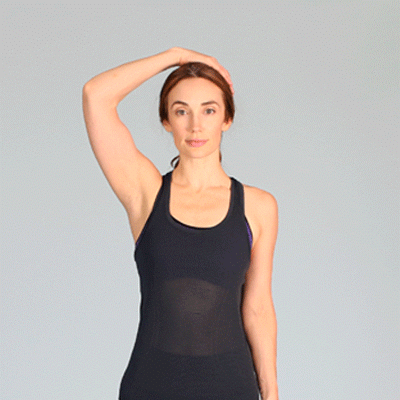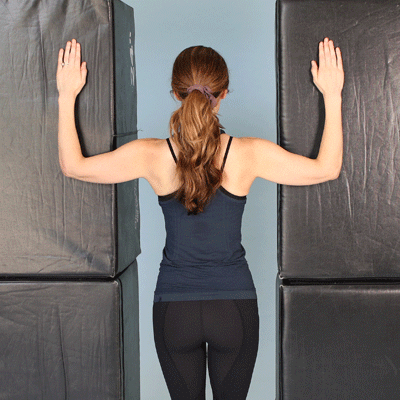Some stretching and strengthening exercises may help correct rounded shoulders, muscle imbalances, and posture. These can be performed standing, sitting, or lying down.
Everyday activities like sitting, exercising, driving, and standing could make us round our shoulders.
Bad posture from rounded shoulders may trigger everything from neck, head, and lower back pain to decreased range of motion and poor circulation.
Austin Martinez, MS, CSCS, ATC, director of education for StretchLab, said the rounded shoulder position is often associated with “upper crossed syndrome.” This condition is characterized by tight chest muscles (pectoralis major/minor) and neck/shoulder muscles (levator scapulae).
Fortunately, some exercises and stretches could help improve your posture.
Here are 6 moves to open up your chest, relax your shoulders, and correct your posture.
Martinez said this stretch targets the trapezius and scalene muscles, which play a role in posture and breathing throughout the neck and shoulders.
- Stand or sit upright in a chair with your shoulders down and back.
- Gently pull your left ear toward your left shoulder to get a stretch in the right side of your neck.
- Repeat on the other side.
- Complete 1 to 2 sets on each side, holding for 15 to 30 seconds.
The doorway stretch is a top pick for rounded shoulders, said John Gallucci, Jr., DPT, MS, ATC, physical therapist and CEO of JAG-ONE Physical Therapy. This move opens the chest while gently stretching the shoulders.
- Stand with a doorway about 1 to 2 feet in front of you.
- Bend both your elbows to 90 degrees and raise your arms so your upper arms are parallel to the floor. Place your forearms on either side of the doorway.
- Step forward, placing one foot on the other side of the doorway.
- Slowly shift weight onto the front foot until you feel a stretch in your chest. Hold.
- Complete 3 sets for 15 to 30 seconds each, two to three times daily.
The reverse shoulder stretch opens up the chest and stretches the shoulders and biceps. However, it requires shoulder flexibility, so shorten the range of motion if you feel pain while performing this stretch.
- Stand looking straight ahead, feet shoulder-width apart and arms by your sides.
- Clasp your hands behind your back with thumbs pointing toward the floor.
- Stand tall, open your chest, and move your hands back and toward the ceiling. Stop when you feel a stretch in the shoulders and biceps muscles.
- Hold this position for 20 to 30 seconds.
- Release the stretch and return hands to the starting position.
- Complete 2 sets, holding 20 to 30 seconds each, once or twice daily.
The prone I, T, Y exercise helps strengthen the smaller stabilizing muscles in your shoulders and upper back.
- Lie on your stomach, forehead touching the ground, arms straight above your head, and hands in a thumbs-up position.
- Raise your arms as high as you can, pause, and then slowly lower them back down.
- Move arms out into a “Y” position, raise them as high as possible, and slowly lower them back down.
- Move arms out into a “T” position, raise them as high as possible, and slowly lower them back down.
- Return to the “I” position and repeat.
- Complete 2 sets of 10 reps, once or twice daily.
The band pull-apart exercise opens up the chest and strengthens your upper back and rear shoulder muscles. For this exercise, you’ll need a resistance band. The band strength depends on your strength level.
- Stand upright with back straight, feet shoulder-width apart, and knees slightly bent.
- Hold the band with an overhand grip and your arms straight out in front of you.
- Slowly pull your hands apart by squeezing your shoulder blades together.
- Focus on the squeeze by imagining a small ball between your shoulder blades.
- Slowly return the band to the starting position.
- Complete 2 sets of 10 to 12 reps, once or twice daily.
Scapular wall slides
- Stand with your back against a wall, arms at your sides. Make sure your head, upper back, and glutes are in contact with the wall. Your feet will be slightly away from the wall.
- Raise your arms overhead and press them into the wall, palms out with knuckles touching the wall.
- Bend the elbows to 90 degrees while keeping arms against the wall. This is the starting position.
- From this position, slowly slide your arms up the wall as high as you can go without your back, shoulders, elbows, or wrists coming off the wall.
- Pause at the top of the movement.
- Slowly lower your arms by sliding them down the wall to the starting position (elbows bent at 90 degrees). This movement is slow and controlled.
- Complete 2 sets of 10 reps once or twice daily.
First-line treatment for correcting rounded shoulders includes stretching and strengthening.
Beyond that, Gallucci said soft tissue mobilization by a physical therapist can loosen the tight muscles in the chest region, which may occur due to the hunched-over position.
You may also benefit from wearing a shoulder posture brace, which keeps your neck and shoulders in the correct position. A doctor or physical therapist could assist in fitting one that works for you.
Gallucci said you don’t need to avoid specific exercises as long as you’re not experiencing pain or discomfort. What he does recommend, however, is stretching and strengthening.
“Hunched or rounded shoulders are most often experienced due to a muscle imbalance between the chest and shoulder/upper back region,” said Gallucci.
To correct the imbalance, he said stretching and strengthening should target the chest and upper back, not specifically one or the other. When performing exercises, ensure your spine is straight and you’re not hunching over.
Can rounded shoulders be corrected?
In most cases, strength exercises and stretches that target the core, chest, and back could help correct rounded shoulders. However, if you have very severe kyphosis, you may require surgery to correct your rounded shoulders and spine, but this comes with several risks.
How long does it take to get rid of rounded shoulders?
The time it takes to get rid of rounded shoulders will depend on many factors, such as the severity of the condition, your lifestyle, and overall health. A healthcare professional or physical therapist could provide a timeline specific to your condition.
How to sleep to fix rounded shoulders?
The best sleeping position for rounded shoulders isn’t fully determined. Some
Rounded shoulders are a common issue for many people. By following a stretching and strengthening program designed specifically for this issue, you can help correct muscle imbalances and improve posture.
As always, if you’re experiencing any pain or discomfort while doing these exercises, stop what you’re doing and ask a physical therapist or fitness expert to demonstrate these moves with the correct form.



